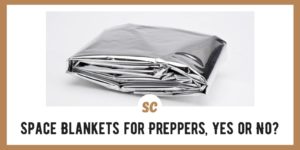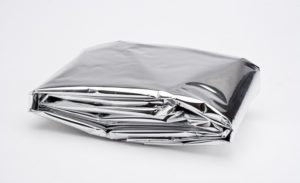A quick internet search will reveal a lot, and I mean a lot of tools, gear, and supplies marketed towards preppers. A good number of those items we don’t even question if we need, such as a quality knife or a butane lighter for starting a fire.
On the other hand, there are some items worth questioning whether we need them or not. One such item I have heard brought up many times in conversations is the space blanket or the emergency blanket as it is more commonly referred to these days. The general question being asked is, “do preppers need space blankets?”
That is what today’s article is about and to answer that we need to talk about what a space blanket is and its capabilities. Let’s jump right into it.
SKIP AHEAD
What is a Space Blanket?
As I mentioned before, space blankets are more commonly referred to as emergency blankets although not all emergency blankets are space blankets.
Space blankets got their name because they were originally designed by the National Aeronautics and Space Administration (NASA) for astronauts to use in space. Pretty cool, huh?
The body loses heat in four different ways, conduction, convection, radiation, and evaporation. A space blanket primarily works by reflecting heat back to the body that would otherwise be lost through radiation.
Capabilities
The space blanket is an incredibly thin (around 12 microns thick) piece of plastic covered in a metal coating. This makes the blanket exceptionally lightweight and compact. If you have never held a space blanket they weigh next to nothing and when properly folded up they are slightly larger than a deck of playing cards.
Their weight and size are big advantages for emergency use because they are so easy to store and carry. When they are brand new a space blanket usually comes in a small plastic pouch that can slide into a standard pants pocket but when it is unfolded a blanket can be easily wrapped around an average-sized person.
Putting a space blanket away after use can be frustrating and is a similar experience to folding up a paper road map (not sure how many people remember those days) but through patience and perseverance, the blanket can be folded back into its original, compact size.
The Elements
Space blankets are waterproof and windproof which make them well suited for being used in most environments. This is a big advantage in staying warm because wind and moisture (being wet) can suck the heat right out of a person.
The problem is that a space blanket can be difficult to seal all around the entire body, so keeping wind and water out completely may be tricky.
However, being waterproof and windproof comes in handy when the blanket is used as a material for making a shelter or for lining the inside of a small space, such as the inside of a vehicle.
Durability
This is probably the space blanket’s biggest weakness. As mentioned before the thickness of one of these blankets usually starts at around 12 microns and then gets slightly thicker depending on how many layers are added to it. To give you a frame of reference for this, a space blanket can be similar in thickness to a human hair.
The blankets do have some give and take but they are quite vulnerable to punctures that could be caused by any object with a ragged or sharp edge or a point.
Once a puncture has been made in a blanket, it does not take much for it to rip and tear from that point. The older style emergency blankets and some that are still around today would literally tear as easily as tissue paper. This is one reason that people who carry emergency blankets will also carry fabric patching kits or a supply of duct tape.
Alternate Uses
One of the great things about a space blanket is that it is one of those products that have multiple uses other than simply wrapping it around the body.
Since it is waterproof and windproof it can be used as a small, improvised shelter, think of a lean-to. Or it can be used as an additional layer when building a shelter to help keep water and wind from getting in.
Since it works by reflecting radiated heat, the blanket can be hung up inside of a shelter, vehicle, or set up around a campfire. Take extreme care when using a space blanket around a heat source because if it gets too close it will melt.
Lastly, a space blanket makes an excellent signaling device because as emergency signaling devices go they are quite large and they reflect light very well. Some blankets only have one shiny side while others have two. If you are using the blanket as a signaling device be sure to have the shiny side positioned towards the direction you wish to signal.
Pros & Cons of Using Space Blankets
Pros
- Very affordable
- Lightweight and compact
- Can be used as a blanket, reflector, or raw material for a shelter
- Reflects between 80-90 percent of body heat
- Waterproof
- Windproof
- Can be used as a signaling device
Cons
- Difficult to wrap around the entire body
- Not very durable
- Can be frustrating to fold back up
- Designed for emergency use, usually thought of as a one-and-done type of product.
Verdict
I feel that most people’s issue with the space blanket is that they forget its other name, which is an emergency blanket. It is meant to be used in an emergency and like some emergency products it’s designed to only be used once.
If you are very careful in handling and storing the blanket then it can be used multiple times. As long as a person realizes that a space blanket shouldn’t be used as a primary means of staying warm, nor should it be your primary blanket for camping, hiking, or to simply throw on the couch, then I don’t see a reason why preppers wouldn’t have a few of these stashed in their vehicles, packs, and homes. When they are used properly, they can be a useful item to have.
What are your thoughts, should preppers have space blankets? Let us know by leaving a comment below. Thanks for reading, stay warm, and stay prepared!



